Cumulative Home Run Ratio and today’s home run hitters
This article follows up on research that first appeared in “Cumulative Home Run Frequency and the Recent Home Run Explosion”, by Gabriel Costa, Michael Huber and John Saccoman, from the 2005 Baseball Research Journal.
 While the Cumulative Home Run Ratio (CHR) has already been defined by the authors of “Cumulative Home Run Frequency and the Recent Home Run Explosion” as the amount of accumulated home runs divided by accumulated at bats, the study of career 500-home-run hitters in that article only covered until the 2004 season.[fn]Costa, Gabriel; Huber, Michael; and Saccoman, John. “Cumulative Home Run Frequency and the Recent Home Run Explosion”. The Baseball Research Journal, 2005: 37-41.[/fn] Since then, many talented home run hitters have surpassed the historic 500-home-run mark. Joining the list are sluggers Frank Thomas, Gary Sheffield, Manny Ramirez, Jim Thome and Alex Rodriguez. While the first three have since retired, Thome and Rodriguez continue to tally up home runs today.
While the Cumulative Home Run Ratio (CHR) has already been defined by the authors of “Cumulative Home Run Frequency and the Recent Home Run Explosion” as the amount of accumulated home runs divided by accumulated at bats, the study of career 500-home-run hitters in that article only covered until the 2004 season.[fn]Costa, Gabriel; Huber, Michael; and Saccoman, John. “Cumulative Home Run Frequency and the Recent Home Run Explosion”. The Baseball Research Journal, 2005: 37-41.[/fn] Since then, many talented home run hitters have surpassed the historic 500-home-run mark. Joining the list are sluggers Frank Thomas, Gary Sheffield, Manny Ramirez, Jim Thome and Alex Rodriguez. While the first three have since retired, Thome and Rodriguez continue to tally up home runs today.
 As a baseball player myself, I can say I agree with the saying “chicks dig the long ball”. There is something to be said about watching a baseball explode off a bat and travel 500 feet through the air. Thus, the home run has always been the most studied and talked-about statistic in baseball. To continue with the trend, I have decided to carry on the previous study to include the five new 500-home-run hitters. The results seem to show a divide, with some similar to those of sluggers in the late 1990s and some similar to the home run hitters of the “pre-steroid” era.
As a baseball player myself, I can say I agree with the saying “chicks dig the long ball”. There is something to be said about watching a baseball explode off a bat and travel 500 feet through the air. Thus, the home run has always been the most studied and talked-about statistic in baseball. To continue with the trend, I have decided to carry on the previous study to include the five new 500-home-run hitters. The results seem to show a divide, with some similar to those of sluggers in the late 1990s and some similar to the home run hitters of the “pre-steroid” era.
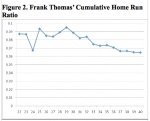 First, let us look at the CHR ratios for Manny Ramirez and Frank Thomas. As seen in Figures 1 and 2, both of the sluggers’ CHR ratios look relatively constant. Looking at the graphs with an x-axis of age and y-axis of CHR ratio, both contain a relatively constant slope, with relatively small variability, and most importantly, their CHR ratios seem to level off during their mid-twenties. These results seem to be similar to that of Ted Williams, a hitter deemed a “natural hitter” by Pulitzer Prize-winning writer Author Daley in the early 1950s.[fn]Daley, Arthur. “What is a Natural Hitter?” Baseball Digest, 1946: 23-24.[/fn]
First, let us look at the CHR ratios for Manny Ramirez and Frank Thomas. As seen in Figures 1 and 2, both of the sluggers’ CHR ratios look relatively constant. Looking at the graphs with an x-axis of age and y-axis of CHR ratio, both contain a relatively constant slope, with relatively small variability, and most importantly, their CHR ratios seem to level off during their mid-twenties. These results seem to be similar to that of Ted Williams, a hitter deemed a “natural hitter” by Pulitzer Prize-winning writer Author Daley in the early 1950s.[fn]Daley, Arthur. “What is a Natural Hitter?” Baseball Digest, 1946: 23-24.[/fn]
To contrast those results of the “natural hitter”, we now turn to the CHR results of Gary Sheffield and Jim Thome in Figures 3 and 4. The first observation we make in regards to Sheffield’s CHR is that it is far lower than most 500-home-run hitters. Yet, like the CHR of Thome, Sheffield shows a drastic positive slope with large variability between years. Additionally, Thome’s and Sheffield’s CHRs flatten out in the late twenties and early thirties, rather than the mid-twenties like those of Ramirez and Thomas.
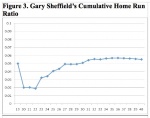 Contrasting these CHRs to a similar list like those of Barry Bonds and Mark McGwire, we might begin to ask ourselves: How do these four hitters continue to produce so many home runs as the body deteriorates with age?[fn]Sports Reference LLC. Baseball Reference. May 22, 2011. http://www.baseball-reference.com (accessed May 20, 2011).[/fn]
Contrasting these CHRs to a similar list like those of Barry Bonds and Mark McGwire, we might begin to ask ourselves: How do these four hitters continue to produce so many home runs as the body deteriorates with age?[fn]Sports Reference LLC. Baseball Reference. May 22, 2011. http://www.baseball-reference.com (accessed May 20, 2011).[/fn]
To address this question, let us look at an active 500-home-run hitter: Alex Rodriguez. Looking at Rodriguez’s CHR ratio we notice a relatively high variability of change as well as a spike in his CHR at age 27. This spike is due to 52, 57 and 47 home-run seasons prior to his 27th birthday. While hitters such as Williams leveled off at this age, Rodriguez produced his best single-season home run total. Entering his age 36 season in 2012, Rodriguez holds a .069 CHR. Using linear regression and a scatter plot (Figure 6), we can use the linear regression equation y = 41.801x – 83.390 to determine when Rodriguez will hit 700 home runs. Plugging in 700 for y and solving for x, we see that if Rodriguez continues on his current home run trend we will see a third 700-home-run hitter by his 20th season — in 2013.
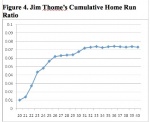 In this case, the use of statistical analysis cannot prove or implicate any individual’s use of performance-enhancing drugs, but it still can raise questions. In 2009, Rodriguez admitted to using steroids to increase power and performance. Did his use of steroids, like many other users, cause a constant increase in CHR, rather than a leveling off near age 27? As the steroid era seems to near an end, we can only let statistics and time tell all.
In this case, the use of statistical analysis cannot prove or implicate any individual’s use of performance-enhancing drugs, but it still can raise questions. In 2009, Rodriguez admitted to using steroids to increase power and performance. Did his use of steroids, like many other users, cause a constant increase in CHR, rather than a leveling off near age 27? As the steroid era seems to near an end, we can only let statistics and time tell all.
Connor Love is a cadet and varsity baseball player at the United States Military Academy at West Point. To learn more about cumulative home run ratio, visit SABR member Gabriel Costa’s sabermetrics course page at http://www.dean.usma.edu/departments/math/courses/ma488/default.htm.
Note: This article was corrected to reflect that Jim Thome is still active as of the 2011 season.
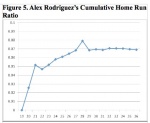
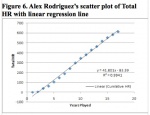
Originally published: January 10, 2012. Last Updated: January 10, 2012.


